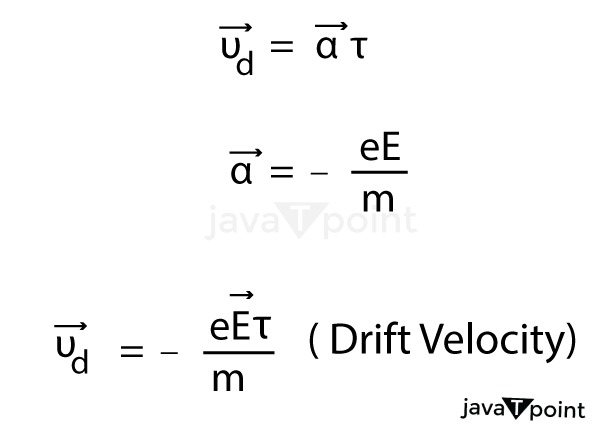Drift Velocity FormulaThe average velocity of charged particles, such as electrons, in a material when they are exposed to an electric field is referred to as drift velocity in physics. It is the rate of motion of these charged particles in reaction to an electric field, to put it simply. 
In the investigation of electrical conductivity in materials, the idea of drift velocity is crucial. The drift velocity formula is one method for calculating a material's conductivity, which is determined by how freely charged particles can move through it. The following is how drift velocity is calculated: vd = μE where vd is the drift speed Mobility of the material's charged particles and E is the electric field intensity. By dissecting each part, the drift velocity formula can be explained in greater detail:
Charged particles within a material experience a force in the field's direction when an electric field is applied to it. The strength of the electric field has a direct relationship to the strength of this force. Drift Speed (vd) The average speed of charged particles in a substance when they are exposed to an electric field is known as the drift velocity. The electric field intensity and particle velocity both play a role in determining it. The charged particles in a material experience a force in the field's direction when an electric field is applied to it. They also run into other particles in the substance, which results in a change in direction and a loss of some energy. The drift velocity formula determines the average speed at which the charged particles move through the material by accounting for both the impact of the electric field and particle collisions. Applications of Drift VelocityThe Drift Velocity Formula's applications Numerous real-world uses for the drift velocity formula can be found in the investigation of material electrical conductivity.
Relationship between Current density and Drift VelocityThe drift velocity formula can also be used to compute the current density in a material. The amount of current flowing through a substance per unit area is measured as its current density. Current density (J) can be calculated as follows: nevdA = J Where: n = number density of charged particles e = charge of each pparticle vd is the drift speed, A = cross-sectional area of the substance The following results can be obtained by replacing the current density formula with the drift velocity formula (vd = μE): J = neμEA. This equation demonstrates how the relationship between a material's current density and electric field strength and charged particle mobility. It also emphasizes how crucial a material's cross-sectional area is in determining how much current may pass through it. Mobility Dependent on TemperatureThe temperature of a substance has a significant impact on the mobility of charged particles within that material. Due to increasing thermal vibrations and particle collisions, mobility often decreases as temperature rises. The formula below can be used to describe this temperature dependence: μ(T) = μ0/ (1 + αT). where: μ0 = movability at absolute zero Temperature. A measure of mobility Temperature is T. According to this formula, mobility diminishes as the temperature rises, but at a slower rate. The mobility nearly reaches a constant value at very high temperatures. Impurity Impacts on MobilityThe mobility of charged particles can also be impacted by impurities or imperfections in a material. Impurities can serve as scattering centers, reducing the energy of the particles and increasing the frequency of direction changes. Matthiessen's rule, which states that the total mobility of charged particles in a material is the sum of the intrinsic mobility (0) and the scattering mobility (s), can be used to explain the effects of impurities on mobility: μ = μ0 + μs. Where: μ0 means inherent mobility, and μs means scattering mobility. This equation demonstrates how impurities or imperfections in a material affect the mobility of charged particles within it. It also implies that by minimizing impurities or enhancing the material structure, intrinsic mobility may be enhanced. For improving the functionality of these materials and creating new technologies, it is crucial to comprehend the elements that influence the mobility of charged particles, such as temperature and contaminants. ConclusionThe drift velocity formula is a crucial instrument in the investigation of electrical conductivity in materials, to sum up. It offers a quantitative assessment of how well-charged particles may travel through a substance in response to an electric field and has a wide range of real-world applications in the creation of electronic devices, the research of semiconductors, and the improvement of electrical systems.
Next TopicAmpere?s Circuital Law
|
 For Videos Join Our Youtube Channel: Join Now
For Videos Join Our Youtube Channel: Join Now
Feedback
- Send your Feedback to [email protected]
Help Others, Please Share









